How to Reduce a Projector’s Throw Distance? Mirror Trick Included!
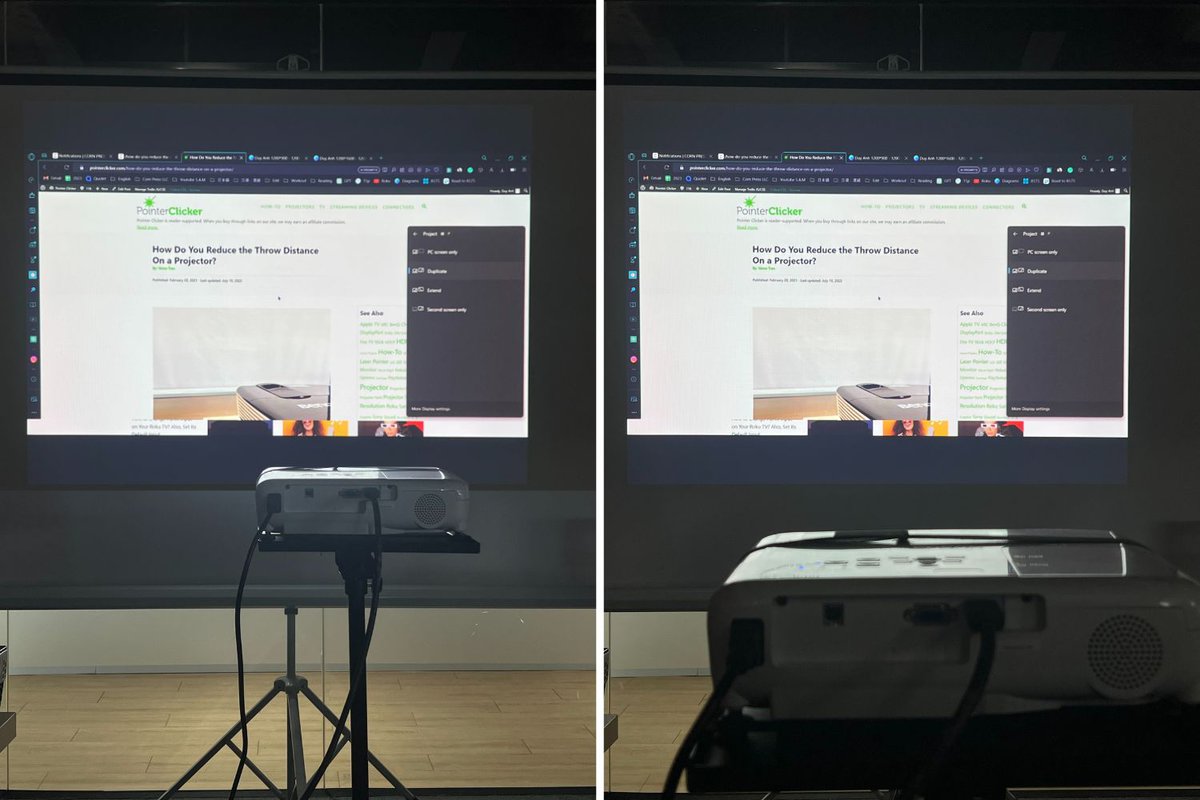
What To Know
- Utilize your projector’s throw ratio and adjust its distance from the screen to optimize image size without needing additional equipment.
- Consider using a short-throw lens or a mirror setup to effectively reduce throw distance if moving the projector closer isn’t feasible.
- If frequent adjustments are needed, investing in a short-throw projector could be a more practical and permanent solution.
In this article, we will discuss how to change your projector setup, swap out parts, and look into different projector options specialized for working up close to a screen.
We will explore:
- The difference between throw ratio and throw distance
- Ways you can reduce throw distance with no extra parts or set up
- Advanced options for reducing throw distance and what you will need
- Whether a short-throw projector is right for you
Quick Navigation
Understanding Throw Ratio and Throw Distance
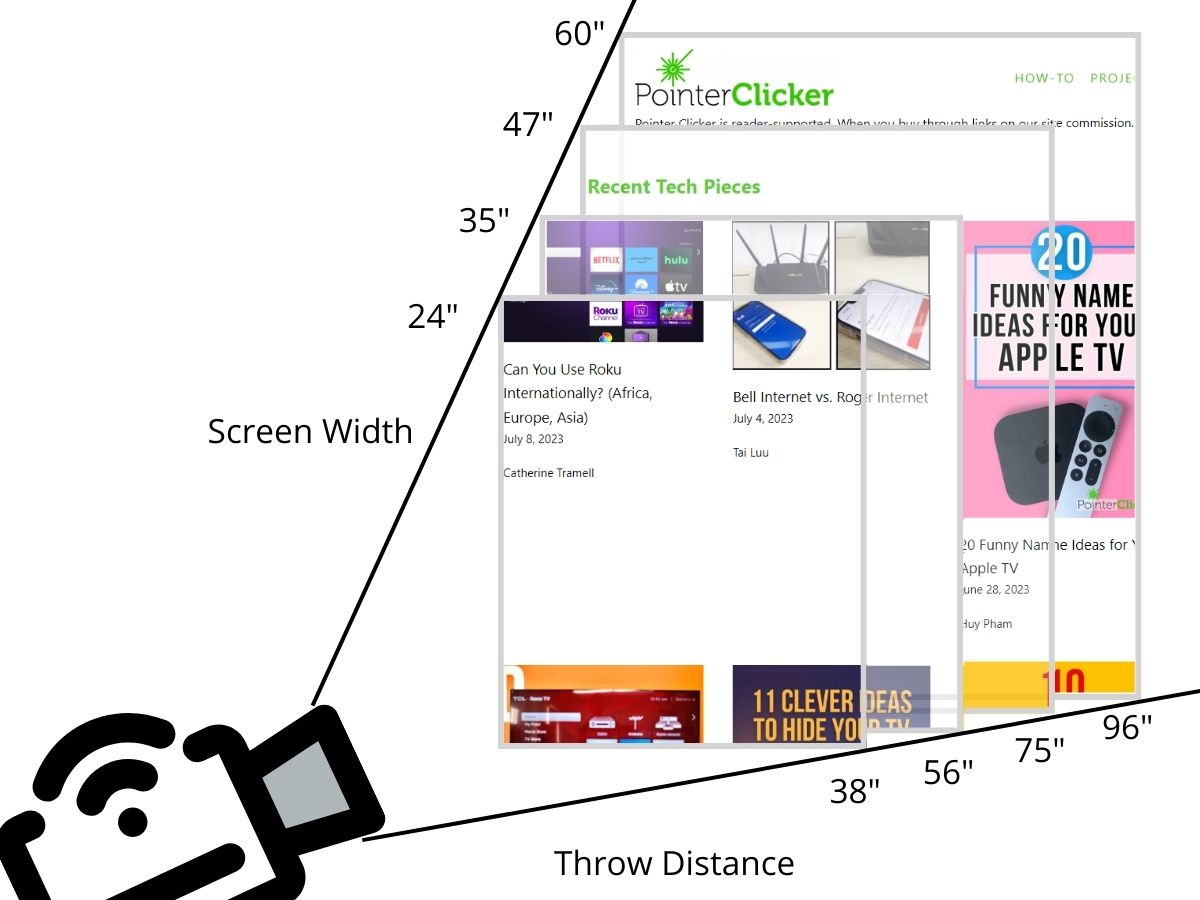
All projectors have something called a throw ratio. The throw ratio is a property of your projector that you can use to calculate how large an image your projector will produce.
The throw distance of your projector depends on where you place it. Throw distance is the distance between your projector and the screen it’s casting an image on.
The throw distance of your projector is technically up to you, as you can place it where you choose. For reasons that will become clear later in this article, projectors will have a minimum throw distance.
I recommend checking your owner’s manual to see what your projector’s recommended or minimum throw distance is. Like with the projector’s throw ratio, this will be different between makes and models.
Typically, you can calculate the width of your projector’s image by dividing the distance your projector sits from your screen by its throw ratio.
If you were to translate that into a mathematical equation, it would look like this:
Screen Width = Throw Distance / Throw Ratio
Let’s work with an example. Most projectors have a natural throw ratio of around 2. This is going to be different depending on the make and model of the projector, but most typical projectors have a throw distance of around 2.
If you took that projector and placed it 10 feet away from the screen, it would produce an image with a diagonal width of 5 feet. The length of the image’s width would run 5 feet from the top right corner of the screen to the bottom left corner of the screen.
The math would look like this:
Screen Width = Throw Distance / Throw Ratio
5 Feet = 10 Feet/2
Here is a Visual Diagram to Clarify:

Ways to Reduce Throw Distance on Your Projector Without Buying Any Add-Ons
Moving your Projector Closer to your Screen
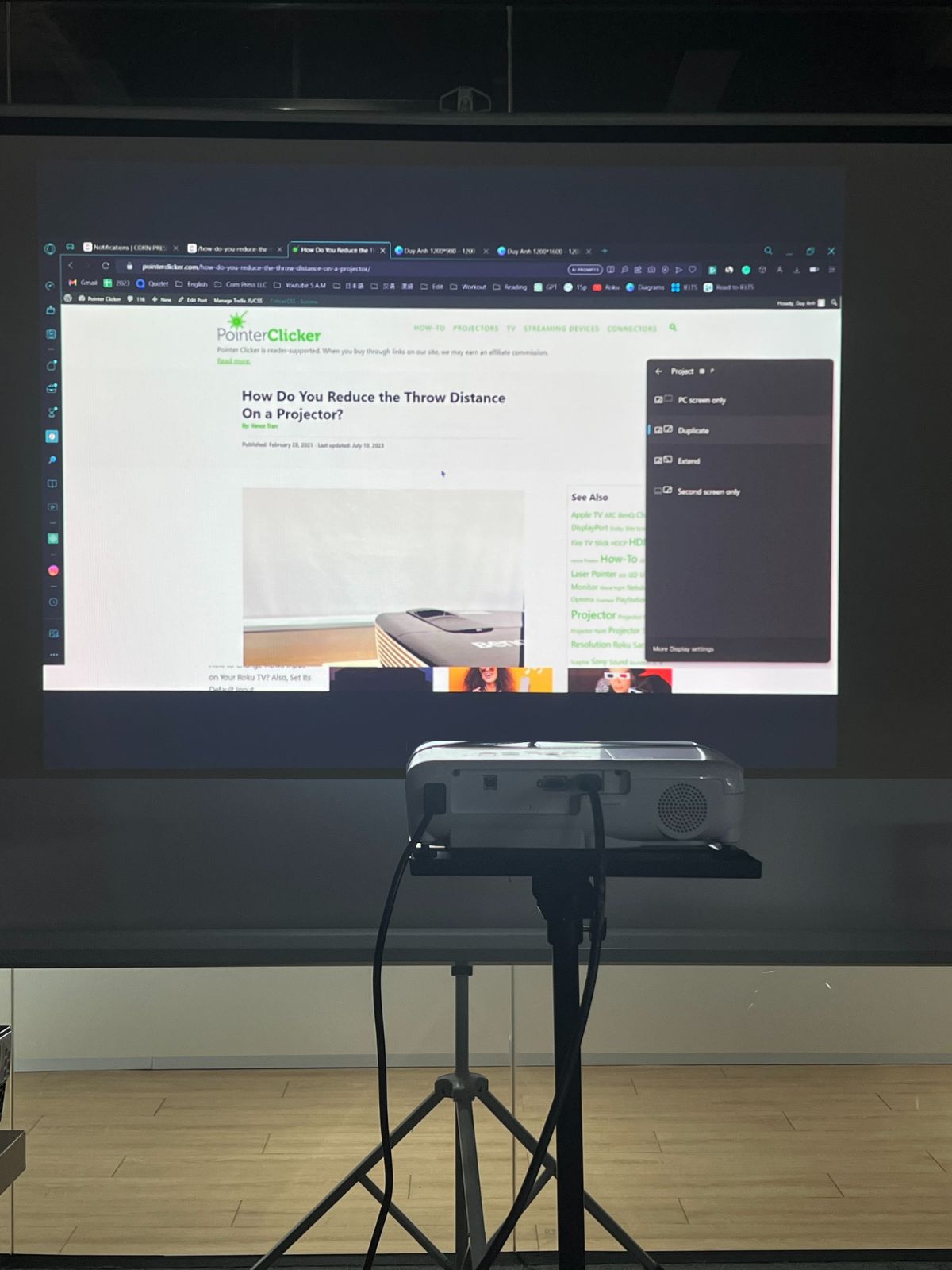
If you want to reduce the throw distance on your projector without swapping out any parts or buying add-ons, you do have that choice.
Since the size of your image depends on the throw distance, you can move your projector closer to your screen if you are fine with a smaller image.
This solution is easy and quick, since it requires no extra parts, modifications, tools, or anything.
I would imagine this is probably not a practice solution for most projector users, since large images are one of the primary reasons to use a projector in the first place.
Even if you were fine with a smaller image, you may still run into problems with the minimum and recommended throw distances for your projector.
Most manufacturers build their projectors to be used at a specific throw distance. If you move your projector too close to the screen, you may start to notice some unusual issues with image quality as a result of not using the right throw distance.
If you move your projector up closer to your screen, you may notice distortions in color and brightness, along with hot spots on your screen as a result of the image being too small.
Adjusting Throw Ratio by Adjusting the Aspect Ratio of your Projector
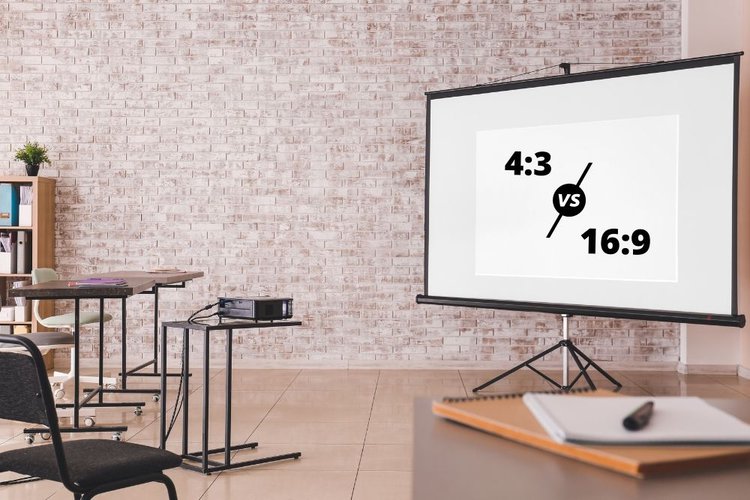
If you need to reduce the throw distance of your projector, and do not want to settle for a smaller image, you have one other choice that will not need any extra equipment.
If your projector allows you to switch the aspect ratio of your image to widescreen, that will decrease the throw ratio of your projector by a small amount.
Remember, a smaller throw ratio is going to create a bigger image if you hold the throw distance steady. If you want to reduce your throw distance, but don’t want your image to get too small, switching your image to widescreen might make the difference.
Unfortunately, this is situational. If you are already running your projector on widescreen, you can’t make it any wider to change the throw ratio.
Since this trick is quick and won’t cost you any extra, it’s worth a try if you are experimenting to reduce your throw distance.
Here’s an example video on how to change your projector’s aspect ratio. Each projector will be different, but most projectors will have a similar menu.
Easy Modifications You Can Do to Reduce Your Projector’s Throw Distance
Anything that won’t cost you any extra parts or hassle with the setup is worth looking into. Now that we have explored the easiest options, let’s move on to more elegant solutions for reducing throw distance.
Like before, we are going to explore how changing throw distance and throw ratio will change your experience with your projector.
We will explore using a short-throw lens to change your ratio, and a mirror setup to increase your throw distance without needing extra space.
Here is a list of what you will need:
- Short-Throw Lens
- Ultra Short-Throw Lens
- First Surface Mirror
Short-Throw or Ultra Short-Throw Lens

A short-throw lens is a replacement lens that dramatically changes the throw ratio. The kind of short-throw lenses available to you will vary based on the make and model of your projector.
Short-throw lenses can allow a projector to work well with a throw distance between 3 feet and 8 feet. This can be a perfect solution if you need to run a projector in a small room.
You will need to swap out your projector’s lens with a short-throw lens if you want to use it. Depending on the projector, it should not be more difficult than replacing the bulb.
This is going to take some technical skill, and might even void your projector’s warranty if you are replacing parts. Check your projector’s manual for instructions.
It’s possible that your projector’s manufacturer might recommend certain short-throw lenses that they produce, which would be covered by your warranty.
If a throw distance of 3 feet is still too much for you, many projectors also have ultra short-throw lenses. An ultra short-throw lens works with a throw distance of as little as 1 foot from the screen, making them great for back projection set-ups.
Changing lenses is probably going to be the easiest choice to reduce your projector’s throw distance. If you need to make more than a slight change, this is the way to go.
Here is a video showing how to install a short-throw projector lens. Each projector will be different, but this should give you a good idea of the process.
Setting Up Mirrors to Stretch Your Throw Distance
What can you do to reduce your throw distance if you can’t move a projector, suffering through a small image size won’t work, and you don’t have short-throw lens options? You can set up a mirror to cheat more throw distance into your setup.
By shining your projector off of a mirror, you can reduce the distance between your projector and your screen without actually reducing your throw distance.
If you are looking for a solution to set up an older projector in a tight space, this could be a good setup for you.
The throw distance between your projector and the screen refers to the distance the light from your projector travels, after all. It does not have to be a measure of the shortest distance between your projector and your screen.
For example, check out this diagram below:
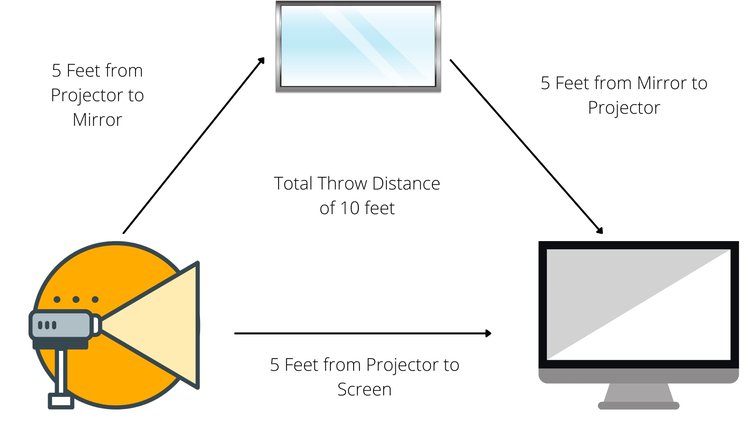
In this example, the projector is 5 feet away from the projector, but the throw distance for the projector is 10 feet.
Instead of going straight from the projector to the screen, the light from the projector travels 5 feet to the mirror, and then another 5 feet to the screen, effectively turning 5 feet of space into 10 feet of throw distance.
Creating a setup like this is probably going to take some trial and error. Setting up the right angles on the mirror, as well as getting the right size of the mirror will all be important.
Professionals often use mirrors in rigging and projector set-ups, so you can do it. It does work. I would recommend trying a setup with whatever mirror you have at home before upgrading to a larger size or to professional equipment.
If you do choose to set up a mirror to increase your projector’s throw distance, you will want to use a first-surface mirror.
A first surface mirror is a mirror that has a reflective surface on the outside, attached to a strong, non-reflective backing.
First-surface mirrors are different from standard mirrors, which often keep their reflective surface behind a protective transparent layer of plastic or glass.
The transparent layer is great for keeping the reflective surface polished and safe, but it can create a ghosting effect when used with a projector.
Ghosting happens when the transparent layer of the mirror creates a second reflection on the surface. Since a projector is going to be shining a large amount of light, this can create a notable, faint second image on a reflected screen.
A first-surface mirror will be damaged more often and will have to be polished, but it will offer you a much sharper image when used to bounce light from a projector.
Once again, here is a Youtube video for a visual example.
Is a Short-Throw Projector Better?
A short-throw projector is exactly what it sounds like. It’s a projector built to have a much smaller throw ratio than a standard projector, and often has minimum throw distances of 1 to 3 feet right out of the box.
A short-throw projector may be a better choice for you, depending on your situation. Here are the pros and cons of using a short-throw projector.
| Advantages of a Short-Throw Projector | Disadvantages of a Short-Throw Projector |
|
|
Conclusion
We have made every effort to cover every possible solution for reducing the throw distance on a projector. You can probably find the right choice for you based on how eager you are to try these solutions for yourself.
If you are interested in the idea of experimenting with your projector setup, setting up mirrors, trying different lenses, and researching the technical specs of your projector, you should probably follow up on what we suggested to make the most out of your projector.
If you find the idea of setting up mirrors and looking into aftermarket parts for your projector, you are probably better off looking into a short-throw projector as a permanent solution.
If you need to set up your projector in different settings and work with varying throw differences, do not get a short-throw projector. The limited options will probably be more of a frustration than convenience in that situation.
Meet Vance. He’s a proud dad, a seasoned Electronics Engineer, and an avid tech lover. His proficiency in electronics and troubleshooting skills were instrumental in crafting Pointer Clicker. Vance is passionate about simplifying tech for those who aren’t well-versed in it.


How to do the opposite? My projector is now standing just a little bit too far, just able to creating a sharp (enough) image that however is substantially too large for the screen it’s casting on, which is a part of wall in-between a closet on the left and the window/curtains on the right. I cannot move the closet further left to widen the wall-part bc then it’ll block the entrance door. Part of the image (±10%) is now cast onto the closet and part (±10%) is cast on the curtains. There’s also a part (±2%) cast onto the ceiling but I’m less bothered by that.